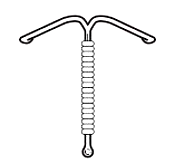
The given figure shows one of the elements releasing intrauterine device. Select the option which shows the correct identification of the device and its feature.

A) CuT: Suppress sperm motility and its fertilizing capacity.
B) CuT: Make uterus unsuitable for the attachment of blastocysts.
C) Lippes loop: Protect the users from contracting AIDS and STDs.
D) LNG-20 Acts as spermicidal means and decrease the contraceptive efficiency.

Answer
359.4k+ views
Hint: A thin copper-containing wire is wrapped around a flexible, "T"-shaped piece of plastic to create the simple copper-releasing IUD known as the CuT. It aids in the production of fluid in the fallopian tubes and uterus that kills sperm.
Complete Step by Step Answer:
A form of intrauterine device that contains copper is an intrauterine device (IUD) with copper, commonly referred to as an intrauterine coil. Within five days of unprotected sex, it is used as emergency contraception and for birth control. It is one of the most successful birth control methods, with a 0.7% failure rate after one year.
It aids in the production of fluid in the fallopian tubes and uterus that kills sperm. White blood cells, copper ions, enzymes, and prostaglandins are all present in this fluid. Due to the direct toxicity of copper ions to sperm, copper ions hinder conception by preventing sperm motility. Even if a small, aggressive spermatozoan successfully fertilises an egg, the environment's high concentration of copper ions hinders implantation of the fertilised egg and subsequent pregnancy.
Hence, option A is the correct answer.
Note: A doctor or nurse will insert an IUD, a tiny T-shaped plastic and copper device, into your uterus. It prevents pregnancy for five to ten years by releasing copper to prevent conception.
Complete Step by Step Answer:
A form of intrauterine device that contains copper is an intrauterine device (IUD) with copper, commonly referred to as an intrauterine coil. Within five days of unprotected sex, it is used as emergency contraception and for birth control. It is one of the most successful birth control methods, with a 0.7% failure rate after one year.
It aids in the production of fluid in the fallopian tubes and uterus that kills sperm. White blood cells, copper ions, enzymes, and prostaglandins are all present in this fluid. Due to the direct toxicity of copper ions to sperm, copper ions hinder conception by preventing sperm motility. Even if a small, aggressive spermatozoan successfully fertilises an egg, the environment's high concentration of copper ions hinders implantation of the fertilised egg and subsequent pregnancy.
Hence, option A is the correct answer.
Note: A doctor or nurse will insert an IUD, a tiny T-shaped plastic and copper device, into your uterus. It prevents pregnancy for five to ten years by releasing copper to prevent conception.
Recently Updated Pages
Capping is a process in which A adenylate is added class 12 biology NEET_UG

Explain in brief the separation and isolation of DNA class 12 biology NEET_UG

Number of testicular lobules in testes is A 250 B 500 class 12 biology NEET_UG

Why are manures considered better than fertilizers class 11 biology CBSE

Find the coordinates of the midpoint of the line segment class 11 maths CBSE

Distinguish between static friction limiting friction class 11 physics CBSE

Trending doubts
What is BLO What is the full form of BLO class 8 social science CBSE

What is meant by exothermic and endothermic reactions class 11 chemistry CBSE

Which places in India experience sunrise first and class 9 social science CBSE

What are the major means of transport Explain each class 12 social science CBSE

Which are the Top 10 Largest Countries of the World?

Fill the blanks with the suitable prepositions 1 The class 9 english CBSE




